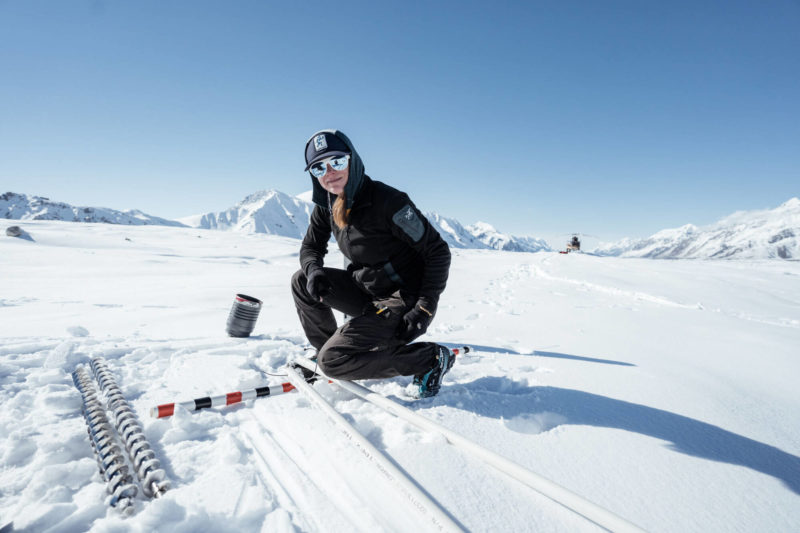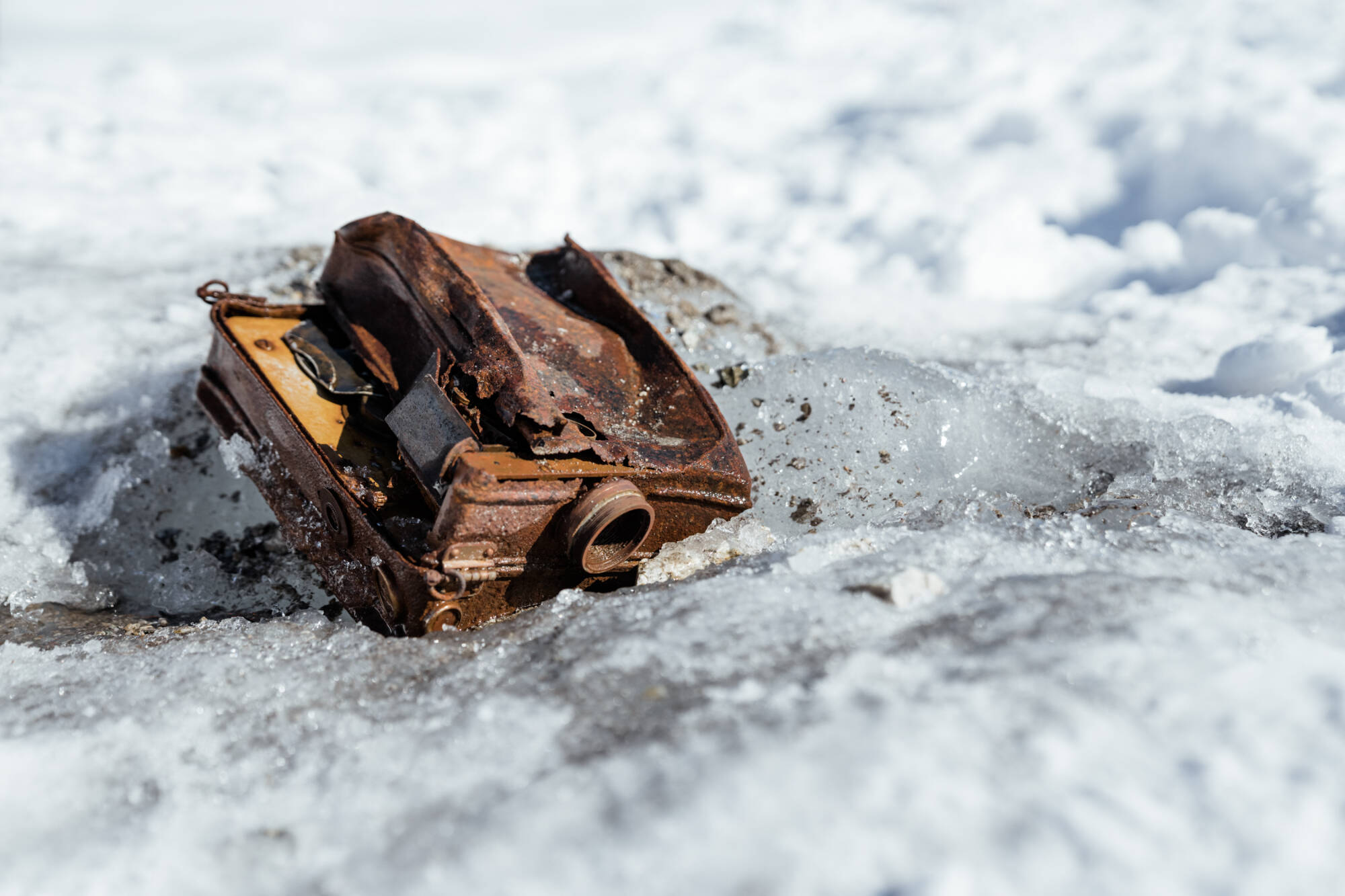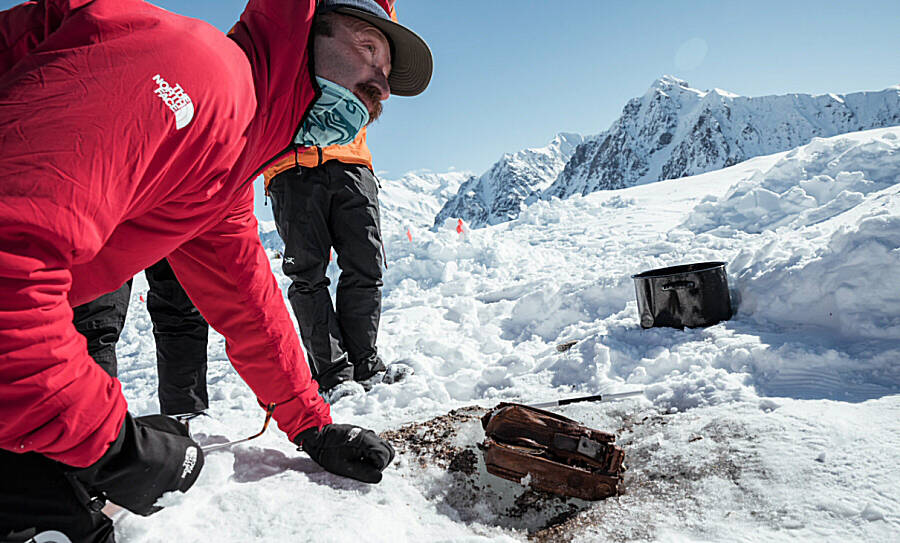An exciting discovery for both glacial science and the history of mountain exploration has been freed from the ice of a glacier in the Yukon’s Kluane National Park.
The find, an 85-year-old cache of supplies, was left behind by mountaineers Bradford Washburn and Robert Bates, who stashed it in order to get away from the glacier and back to civilization when an expedition up Canada’s third-highest peak didn’t go to plan.
The cache was located by an expedition organized by media company Teton Gravity Research and led by professional skier and mountain explorer Griffin Post. It was found on the Walsh Glacier near the Yukon/Alaska border in the traditional territory of the Kluane First Nation. Footage from trips to the Mount Lucania area will be cut together into a film tracing the search for the lost cache.
READ MORE: First all-woman team among mountaineers heading to Yukon’s Kluane National Park
The expedition
Washburn and Bates made the first-ever ascent of Mount Lucania in July of 1937. Their expedition met difficulty and strayed far from the plan. Only the mountaineers’ immense skill and determination allowed them to reach the summit and get safely out of the St. Elias Mountain Range.
According to Voices from the Mountains, a 2006 book by Stephen Venables, Bates was a veteran of perilous expeditions to K2, the world’s second-tallest peak and Washburn had pioneered a route up Denali and also made other cutting-edge climbs in Alaska.
The men’s Mount Lucania expedition hit serious difficulties early on when the ski-equipped plane they used to land at the base of the mountain became bogged down in slush. Although three earlier flights for cacheing equipment had gone smoothly, the fourth left Bates, Washburn and their pilot Bob Reeves stranded on the glacier with the other two members of the expedition team left behind in Alaska. Days of work followed to free the plane, but the pilot made it clear that he wouldn’t be returning to the glacier.
Undeterred, Washburn and Bates stayed behind, knowing they now faced a journey of more than 160 kilometres following their attempt at Mount Lucania’s summit, if they were going to go for it at all.
READ MORE: 3 Epic highways for your next Yukon road trip
They departed the glacier on June 25, having been forced to leave most of the expedition’s photography and surveying gear behind. With 50 days worth of food and other minimal equipment in tow on a ski sledge and in backpacks, the men slogged through the soft snow on their way to Lucania. It wasn’t until July 7 that they camped on the pass between Lucania’s summit and neighbouring Mount Kling. They were near their goal at the top of Canada’s third-highest peak and also close to a route that they knew could get them out of the mountains, as it had been climbed by another party the previous year.
Having made surprisingly good progress and having plenty of food remaining, Washburn and Bates opted to go for the summit, finally reaching it on July 9. A photograph taken on the peak shows the two men side by side and grinning ear-to-ear following their improvised scramble to the top, but they still faced an imposing journey out. In Voices from the Mountains, Venables writes that more than 95 kilometres of glacier and muskeg, as well as the imposing 5,000-metre summit of Mount Steele, barely shorter than Lucania itself, lay between them and safety.
READ MORE: Take a hike: Popular Yukon Hiking website becoming hardcopy guidebook
After being delayed by fierce winds and having to leave behind excess food and fuel, Washburn and Bates summited Steele. From its peak they might have seen the Donjek River Valley and Kluane Lake, where the nearest settlements lay, to the east. Paring their gear down to next to nothing, they made for a food cache they knew had been left by the previous year’s expedition but found it had been destroyed by bears with only a single jar of peanut butter remaining.
They reached the valley below as hunger became a pressing concern but soon realized that crossing the Donjek River was impossible. They had to march more than 30 km upstream in order to find a place to cross. After crossing, they were able to shoot a rabbit and a red squirrel and also find some mushrooms to keep them going. Ten days after summiting Lucania, and having spent the previous night with their poleless tent as the only shelter from driving rain, Washburn and Bates stumbled upon another party and their pack animals who fed them and helped them get to Burwash Landing.
The search
Nearly a century after Washburn and Bates had made it safely out of the mountains, others were planning to head back in. The Teton Gravity Research expedition, led by seasoned backcountry skier and mountain explorer Griffin Post, began planning a journey to locate the equipment the 1937 expedition had left behind on the glacier. More than a year of planning and preparation went into the summer 2022 expedition.
Post said the cache was a worthy goal for several reasons. He was eager to explore Kluane National Park, one of the largest protected areas in the world and largest continuous icefield on earth that isn’t at the poles. Along with the majestic setting filled with excellent skiing and climbing terrain, Post said the search for Bates and Washburn’s cache felt like a treasure hunt.
“In most of the expeditions I’ve been a part of, there’s some sort of historical element, you know, the history of the area, but not nearly as deep as it went with this one. Setting the whole expedition against the backdrop of the 1937 expedition, I think just gives it so much perspective and even if we hadn’t found the cache, I still think it would have been a pretty good story. A pretty good film,” Post said.
Post consulted all the information he could, reading the correspondence between members of the 1937 expedition as they planned their attempt at the summit of Lucania. The cameras and other equipment were stashed decades before explorers could easily jot down the GPS coordinates where they were left and so finding the cache’s original location required more creativity. Post said he was able to triangulate the original location by comparing photographs taken by the Washburn expedition that captured terrain features in the background with mapping software.
Although the 2022 explorers could have some confidence that they knew where their 1937 counterparts had stashed the gear, there was a problem: The cache was on a glacier and glaciers move.
The scientist
Needing to find out how far the great sheet of ice slowly shifting towards Alaska had carried the Washburn and Bates cache, Post and the rest of the expedition crew turned to Dora Medrzycka a glaciologist working out of the University of Ottawa.
Medrzycka got to work trying to figure out how far the cache might have shifted using satellite imagery and other data. She said this was difficult because good imagery only existed going back 20 years while the cache had been in the ice for 85. Adding to the complexity was the fact that the Walsh Glacier does not move at a steady rate. Medrzycka said it surged forward twice since the 1930s.
Hoping to assist with the search directly, Medrzycka joined the expedition team on the glacier this summer. She said they traversed large parts of the glacier in search of some sign of the cache. Although she got along well with the rest of the expedition, she felt pressure as the one who was guiding the search. Despite the weight of her responsibilities Medrzycka relished her time on the glacier which is studied less than the more easily accessible ones on the eastern end of the Kluane Park ice fields.
Post explained that the search was broadened with the help of drones taking aerial photographs that could be closely searched for any sign of the cache poking through the ice.
Time wore on and the cache remained hidden beneath the ice. Medrzycka said she was beginning to doubt they would find the cache — then came the breakthrough. She was observing the moraines on the surface of the glacier, long bands of debris scraped from the surrounding rocks, when she noticed two distinct gaps. Working from the assumption that the gaps in the moraines corresponded with the glaciers two surges forward since the 1930s, Medrzycka adjusted her calculations.
With a new estimate for the position of the cache in hand, the search resumed.
“We’d fly the drones until we’d run out of batteries, and then in the evenings, go back and look through the photos for any irregularities that might show up in the photos,” Post said.
The searching soon payed off. Post described how some items in the cache were easily visible out on the ice while others were still frozen into the glacier.
In the end, the cache was located approximately 20 kilometres from where it was buried 85 years ago and within 700 metres of where Medrzycka estimated it would be.
The find
“It was so surreal to be looking at these pieces of equipment that hadn’t been seen for 85 years, like long before my parents were born. And just to take that in and also see firsthand what equipment they were using in 1937 to climb Mount Lucania,” Post said.
Medrzycka was thrilled that her estimates worked and finally led the expedition to the cache.
Post described the canvas tents, sleeping bags, tools and even the remains of a t-bone steak cached in the glacier. The most significant items cached were an aerial photography camera and two motion picture cameras with film still loaded inside. The aerial camera is an especially important artifact from this era of mountaineering because it is believed to be the first one Washburn owned. Washburn went on to pioneer aerial photography use in mountaineering, most notably masterminding aerial mapping of Mount Everest decades after his expedition up Mount Lucania.
The gear in the cache was left behind on the mountain after its initial discovery, but Post said he went back with a Parks Canada team in mid-September to recover key items including the cameras and several rolls of film. The recovery expedition came just in time as Post said there was already 30 centimetres of fresh snow on the glacier.
Post said the cameras certainly look like they have spent 85 years exposed to the elements but there is cautious optimism that something can be salvaged from the rolls of film they contain.
“The rediscovery of the Washburn-Bates cache after 85 years locked in the ice adds a tangible dimension to an exciting story of exploration and survival at almost unbelievable odds,” said Sharon Thomson, an archaeologist for Parks Canada.
“From a cultural resource management perspective, it presents a rare and valuable opportunity to study change over time on an archaeological site in a dynamic glacial environment.”
According to Teton Gravity Research, a team of Parks Canada conservators are now working to preserve the items removed from the glacier so they and their stories can be shared with the public for years to come.
Medrzycka agrees that the expedition has provided valuable data points for the study of the glacier but science still doesn’t have all of the details necessary to reconstruct its long-term movement. She said the position of the cache, both in 1937 and 2022, could be used for future study and photos taken by Washburn at his expedition’s base camp can be compared to present photos to assess how the glacier’s thickness has changed. She said any photos that could be recovered from the antique rolls of film that were buried in the ice might also prove helpful.
Post’s admiration for Washburn, Bates and the other mountaineers of their era only grew over the course of the expedition. Seeing the gear they used, mostly wool and wood, a far cry from the lightweight and waterproof wonders mountaineers pack today, Post marvelled at their abilities.
Asked what he would do in the shoes of Washburn and Bates, forced to choose between a flight to safety and a chance at the summit with an uncertain way out, Post wasn’t sure he would follow in the 1937 expedition’s footsteps.
When planning the 2022 expedition, Post said there was some discussion of recreating the whole route taken by Washburn and Bates, who both passed away in 2007. Even with modern equipment, this was considered a massive undertaking.
“It wouldn’t be a gimme at all. Like that would have been such a proper adventure and ultimately, we didn’t do it. It gave me plenty of hesitation just thinking about it,” Post said.
Plan your adventures throughout the West Coast at westcoasttraveller.com and follow us on Facebook and Instagram @thewestcoasttraveller. And for the top West Coast Travel stories of the week delivered right to your inbox, sign up for our weekly Armchair Traveller newsletter!













 Coffee in downtown Everett is the cure for a cloudy day
Coffee in downtown Everett is the cure for a cloudy day